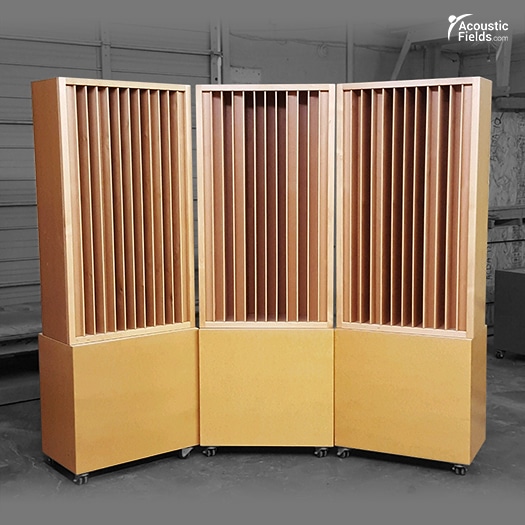The following post on Near Field vs. Far Field is an unedited transcript from our video series from Acoustic Fields. There will be some errors in grammar and sentence structure that occur during this translation process. For complete understanding and comprehension, please view the video which is included in this text. We have updated this blog to reflect on the latest technology regarding Near Field Listening. This blog was updated on 11 / 3 /19.
______
Today we’re going to talk about near versus far field. So let’s start with a few definitions.
Near vs. Far Field
Near field obviously is sitting as close to the speakers as you can. Why do we do this? We do it because if we sit closer to the speakers we get more speaker sound and less room sound. You’re sitting closer to the speakers, you’re dealing with more direct energy and not reflected energy. The direct energy is the straight-line energy from your speakers to your ears. The shortest distance between two points is a straight line. There’s less room sound in a near field listening or monitoring situation. What do you get for that? Detail, image, definition to start with. You get all the things that we crave in our musical presentations.
Far-Field
Far-field, just what the name implies you’re sitting farther back, so you get more of the room sound. Your sound stage is larger, it is more of everything. You’re concerned with the direct – you’re concerned with the direct and the reflected energy and you want to achieve a balance between the direct and reflected energy, so you get a little bit of more room sound.
Definitions: https://en.wikipedia.org/wiki/Near_and_far_field
Control Rooms / Listening Rooms
Control rooms have both near and far-field listening. They’ll have both to see how it’s translating in both situations. Hi-fi has a big far-field listening situation. There’s a trade-off in definition, image, and separation because of the room sound mixed in with the speaker only sound which is near field. It doesn’t have to be like this and can be avoided if one uses the proper treatment but most rooms are not properly treated. Hi-fi rooms are typically farther field, so you’re hearing a sound stage that has width, height, and depth.
Acoustic Goals
At Acoustic Fields, we like the definition that you get with near field listening. We like the image, we like the definition, we like the detail. We also like a broad sound stage that you get with far-field listening. We take the best of both near and far-field and combine them. Our goal is to get the resolution of near field listening with the larger sound stage that goes with listening farther from your speakers. You want to hear more of the straight line or direct energy from your speakers. More direct or pure sound and less reflected or room sound.
Sound Stage
How do we get that big sound stage with a near field listening position? The real answer is that you do not. You must have width and length to achieve a wider, taller, and deeper soundstage. Along with length and width, you must have the proper treatment. You must start with the lower frequencies and treat those first and foremost first since the low frequencies are the parents of middle and high frequencies.
Low-Frequency Management
Low-frequency management is necessary with both far and near field speaker setups. The most powerful low-frequency technology is diaphragmatic absorption. It can go lower in frequency and absorb over a much broader frequency range. We have two frequency ranges we must be concerned about. We need to manage energy from 30 – 50 Hz. and from 30 – 300 Hz. This two frequency ranges are present in all small rooms. You must calculate where the problems lie (which wall) and then apply the right amount and type of absorption technology.
ACDA-10: https://acousticfields.com/product/acda-10-activated-carbon-diaphragmatic-absorber/
ACDA-12: https://acousticfields.com/product/acda-12-activated-carbon-diaphragmatic-absorber/
Diffusion
Diffusion is another technology that we use both near and far-field. Diffusion is a technology to make a small room sound larger. Diffusion properly positioned can make your sound stage sound wider. It can make you sound stage sound taller and deeper. The only true diffusion type is quadratic diffusion which is available in both vertical and horizontal arrays to help you manage all that reflected energy within your small room.
For any additional information regarding this topic or others relating to room acoustics, please contact us directly at:
P: 520 – 392 – 9486
Thank you,
Dennis Foley









The discussion on ductwork noise transmission from Acoustic Fields highlights crucial aspects of HVAC system acoustics. The movement of air…
Great build plans. thank you Denis
You must use absorption. Never place a chair against a wall.
A friend and I built several diffusors using these plans and they turned out absolutely beautiful. Very good instructions and…